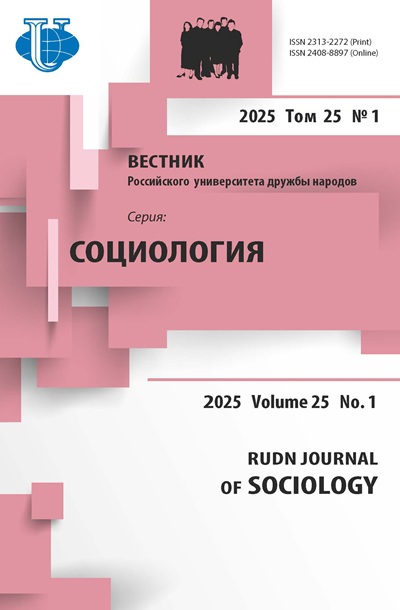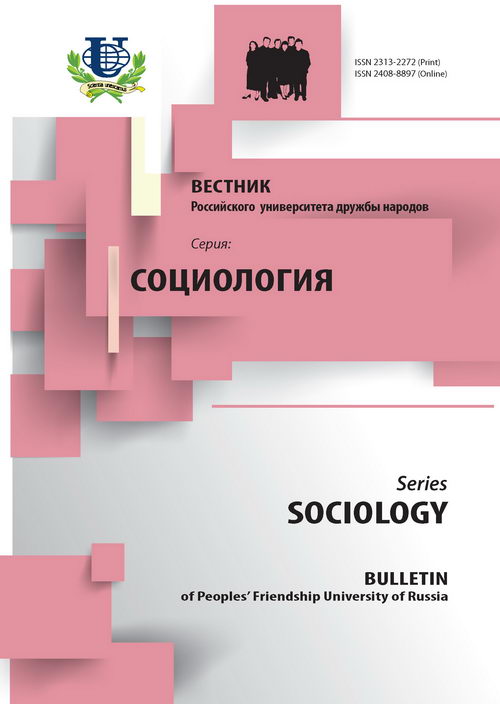The perception of security in the international comparative perspective
- Authors: Díez-Nicolás J1
-
Affiliations:
- Universidad Europea de Madrid
- Issue: Vol 16, No 2 (2016)
- Pages: 219-257
- Section: Theory, Methodology and History of Sociological Research
- URL: https://journals.rudn.ru/sociology/article/view/6466
Cite item
Full Text
Abstract
The author considers security a key value in present societies all around the world due to the general change in values since the end of the 20th century, which is characterized by a certain return to more materialistic values and a reduction of personal and economic security under the globalization. The article provides two different but complementary theoretical frameworks for the sociological study of security. The first theoretical frame was developed in the late 1970’s as a reaction to the excessive optimism generated by the high levels and rates of economic development during the previous years. Within this conceptual frame the author groups 59 countries into seven geo-cultural world regions, and identifies the change in values not only as a reduction of post-materialist values, but also as an increase in desires for greater authority in the future, particularly in more developed societies. In the second theoretical scheme all forms of social organization (political, economic, family, educational, etc.) including value systems, are instruments of adaptation of human societies to their environment. Thus, the main hypothesis here is that values change because of the levels of security in society, both personal and economic security: as security levels rise or decline, values change. The author considers both theoretically and empirically four indexes of security - personal, community, national and total. According to the European surveys data, developed countries seem to feel subjectively more secure than less developed countries, but variation even among countries within the same world geo-cultural region is very wide. On the basis of three sets of variables used to explain the four indexes of security (socio-demographic, attitudinal, national defence and a combination of the previous three) the author shows that the combined set seems to be the most robust to explain all four indexes of security. However, there is a great variation in the levels of the four types of security among the seven geo-cultural world regions, and among the countries within each region. This implies that the country continues to be the most important unit of analysis in international comparisons, which should take into account both subjective and objective measures of security.
About the authors
J Díez-Nicolás
Universidad Europea de Madrid
Author for correspondence.
Email: 100613.2721@compuserve.com
References
- Alkire S. (2003) A Conceptual Framework for Human Security. Working Paper 2. Centre for Research on Inequality, Human Security and Ethnicity, CRISE. Queen Elizabeth House, University of Oxford.
- Arriagada I., Godoy L. (1999) Seguridad ciudadana y violencia en América Latina: diagnóstico y políticas en los años noventa. CEPAL, United Nations. Santiado de Chile.
- Bigo D. (2000) When Two Become One: Internal and External Securisitations in Europe. In M. Kelstrup, M. Williams. International Relations Theory and the Politics of European Integration. Power, Security and Community. London: Routledge.
- Bilgin P. (2003) Individual and societal dimensions of security. International Studies Review. Vol. 5.
- Bosch J.L.C., Farras J., Martin M., Sabate J., Torrente D. (2004) Estado, mercado y seguridad ciudadana: Análisis de la articulación entre la seguridad pública y privada en España. Revista Internacional de Sociología. Vol. 39.
- Butterfield H. (1951) History and Human Relations. London: Collins.
- Brimmer E. (ed.) (2008) Five Dimensions of Homeland and International Security. Center for Transatlantic Relations, The John Hopkins University.
- Dahrendorf R. (1959) Class and Class Conflict in Modern Society. Stanford: Stanford University Press.
- Davis K. (1949) Human Society. London: McMillan.
- Díez-Nicolás J. (1980) La España previsible" (Forecast of Spain). Revista Española de Investigaciones Sociológicas. Vol. 12.
- Díez-Nicolás J. (2009) Cultural differences on values about conflict, war and peace. In Y. Esmer, H.-D. Klingemann, B. Puranen (eds.) Religion, Democratic Values and Political Conflict. Festschrift in Honor of Thorleif Pettersson. World Values Survey. Uppsala University.
- Díez-Nicolás J. (2009) Some theoretical and methodological applications of centre-periphery theory and the social position index. In K. van der Veer, A. Hartmannn, H. van den Berg (eds.), J. Díez-Nicolás, J. Galtung, H. Wiberg. Multidimensional Social Science. Rozenberg, Amsterdam.
- Díez-Nicolás J. (2010) Poder político y poder financiero (Political Power and Financial Power). Tercera, ABC, 30 August.
- Díez-Nicolás J. (2011) ¿Regreso a los valores materialistas? El dilema entre seguridad y libertad en los países desarrollados (Return to materialist values? The dilemma between security and freedom in developed countries). Revista Española de Sociología. Vol. 15.
- Díez-Nicolás J. (2011) La Seguridad subjetiva en España: Construcción de un índice sintético de seguridad subjetiva (ISSS) (Subjective Security in Spain: Construction of a Synthetic Index of Subjective Security). Madrid: Ministerio de Defensa.
- Díez-Nicolás J. (2013) Desequilibrios demográficos (Demographic imbalances). In Instituto Español de Estudios Estratégicos, Los potenciadores del riesgo (Risk Enhancers). Madrid: CESEDEN, Ministerio de Defensa.
- Díez-Nicolás J. (2013) ¿Crisis económica, crisis financiera o crisis del sistema social global? (Economic crisis, financial crisis, or crisis of the global social system?). Revista Española de Sociología. Vol.19. FES, Madrid.
- Díez-Nicolás J. (2013) Measuring the Concept of Security in a Comparative Perspective. Social and Economic Survey Research Institute (SESRI)-World Values Survey-Arab Barometer-Qatar University, Doha.
- Díez-Nicolás J. (2014) La globalización y las crisis (Globalization and Crisis). Tercera, ABC, 11 April.
- Fuentes C.F., Basombrio C.I., Dellasoppa E.E., Frühling H.E. (2011) Seguridad ciudadana en América Latina. Instituto de Asuntos Públicos. Santiago de Chile.
- Galtung J. (1964) Foreign policy opinion as a function of social position. Journal of Peace Research. Vol. 34.
- Galtung J. (1969) Violence, peace, and peace research. Journal of Peace Research. Vol. 6.
- Galtung J. (1976) Social position and the image of the future. In H. Ornauer et al. (eds.) Images of the World in the year 2000. Paris: Mouton.
- Galtung J. (1996) Peace by Peaceful Means: Peace and Conflict, Development and Civilization. London: Sage.
- Haerpfer C., Wallace C. (1997) Internal and external security in post-communist Eastern Europe. Results of a 10-nation study. Institute for Advanced Studies. Wien, Sociological Series. No. 20.
- Haerpfer C., Wallace C., Rose R. (1997) Public perceptions of threats to security in post-communist Europe. Studies in Public Policy. No.293. University of Strathclyde, Glasgow.
- Haerpfer C., Milosinksi C., Wallace C. (1999) Old and new security issues in post-communist Eastern Europe: Results of an 11 nation study. Europe-Asia Studies. Vol. 51. No. 6.
- Halle N.H. (1966) Social position and foreign policy attitudes. Journal of Peace Research. Vol. 1.
- Hawley A.H. (1950) Human Ecology. New York: The Ronald Press Company.
- Hawley A.H. (1962) La Estructura de los sistemas sociales (Structure of Social Systems). Madrid: Tecnos.
- Herz J. (1951) Political Realism and Political Idealism: A Study in Theories and Realities. Chicago: Chicago University Press.
- Ilie F.A. (2012) National and international security objectives: some correlations. Journal of Defense Resources Management. Vol. 3. Issue 1.
- Inglehart R. (1977) The Silent Revolution. Princeton: Princeton University Press.
- Inglehart R. (1990) Culture Shift in Advanced Industrial Society. Princeton: Princeton University Press.
- Inglehart R. (1997) Modernization and Post-Modernization. Princeton: Princeton University Press.
- Jarvis R. (1976) Perception and Misperception in International Politics. Princeton: Princeton University Press.
- Jarvis R. (1978) Cooperation under the security dilemma. World Politics. Vol. 30. No. 2.
- Meadows D.H. et al. (1972) The Limits to Growth. New York: Universe Book.
- Medina J. (2003) Inseguridad ciudadana, miedo al. delito y policía en España. Revista Electrónica de Ciencia Penal y Criminología.
- Newman E. (2010) Critical human security studies. Review of International Studies. Vol. 36.
- Nieto Huertas L. (2003) El estado del arte de la seguridad urbana. Circunstancia. Vol. I. No. 2. Septiembre 1-21.
- Posen B.R. (2006) European Union security and defence policy: Response to unipolarity? Security Studies. Vol. 15. No. 2.
- Rowley C., Weldes J. (2011) The evolution of international security studies and the everyday: Suggestions from the buffyverse. School of Sociology, Politics and International Studies, Working Paper 11-12. University of Bristol.
- Tang S. (2009) The security dilemma: a conceptual analysis. Security Studies. Vol. 18. No. 3.
- Unites Nations (1994) New Dimensions of Human Security. Chapter 2. Human Development Report 1994.














